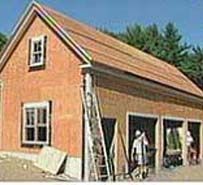
“…and we’ll need a detached garage for three cars. Well, actually three Explorers.”
Dick and Sandy Silva were laying out their must-haves as we sat in their mobile home just days after the fire. From my seat, I was able to look out at their charred three-car carport, which stretched across the southern portion of the property and occupied what could be a wonderful, sunny outdoor space in the new design. This carport, with its flat roof, supporting columns and rear wall, still had a large and imposing presence on the Silvas’ property. Somehow, I hoped, our design for the new garage would make a building that could hold three SUVs seem small. We accomplished this with three techniques:
Detachment
Dick and Sandy’s desire for a detached garage, as opposed to an attached one, helped our design mission immediately. Attach a garage to a house and the result is often a large, bulky mass. Detach the garage and that large mass is broken up, allowing landscaping to
further separate the two buildings. A detached garage does eliminate the sealed, convenient connection of garage to household but by sending us outside it places us in touch with our neighbors, our communities and the daily weather.
Siting
That decided, we next needed to site the structure to diminish its visual impact. Our intuitive response was to turn the garage so that its smaller side, rather than its broad and expansive front, faced the street. In addition to looming large, garage fronts play host to a vast expanse of driveway where they park their SUVs?elements better keep to the sides and rears of any property. As we were hoping to maintain the rural qualities of the Silvas’ property, we looked for a spot to the side or rear of the site that would allow the
front lawn to come right up and touch the street side of the garage.
At my firm, we accept the need for garages and try to see them as providing an opportunity to create private outdoor spaces. We came to think of the Silvas’ garage as a fence. Turned parallel with the side of the property, it became a buffer, shielding the Silvas from views of their driveway and their cars and creating an enclosure for their pool and back yard.
Design
Even before putting pen to paper, we recognized that simply rotating the structure wouldn’t be the whole answer to the problem. We anticipated that the garage would derive its style, detail, color and massing from the “village Victorian” design of the residence. But at a standard dimension of 24 feet, the garage side could begin to overpower the 22-foot central gabled
section of the house.
To minimize the side view of the garage, we did two things. First, we designed an unconventional massing, using a 17-foot wide gabled section, which encloses stair access to the garage and its attic, and a small shed addition, under which the front end of the vehicles would park. Second, we pushed the garage down, taking advantage of the descending grade at the rear of the property. As a result, the base of the building’s street side serves as a retaining wall supporting about three feet of the front yard. It makes for a shorter building.
We added two small dormers to further break up the building’s mass and sided the whole thing in shingles, a step down in refinement from the main house’s clapboards. The result: a garage that looks like an outbuilding in a rural setting. And, most importantly, the house retains top billing.
